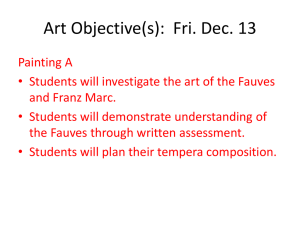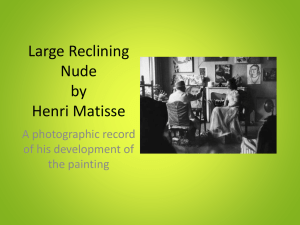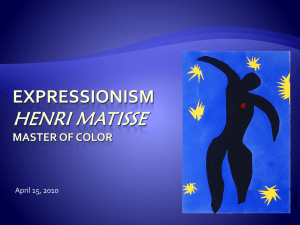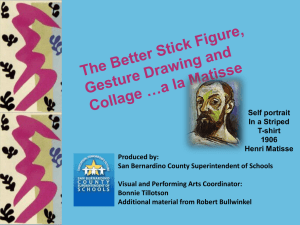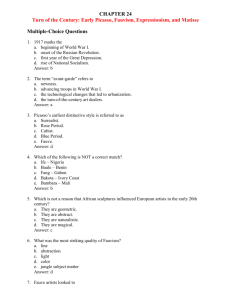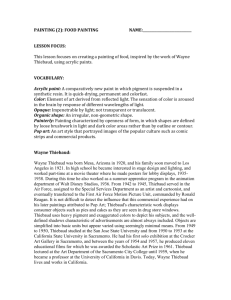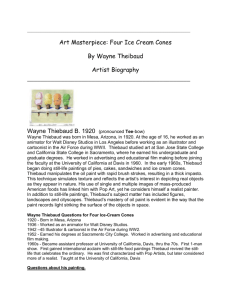Still Life – Matisse and Thiebaud
advertisement
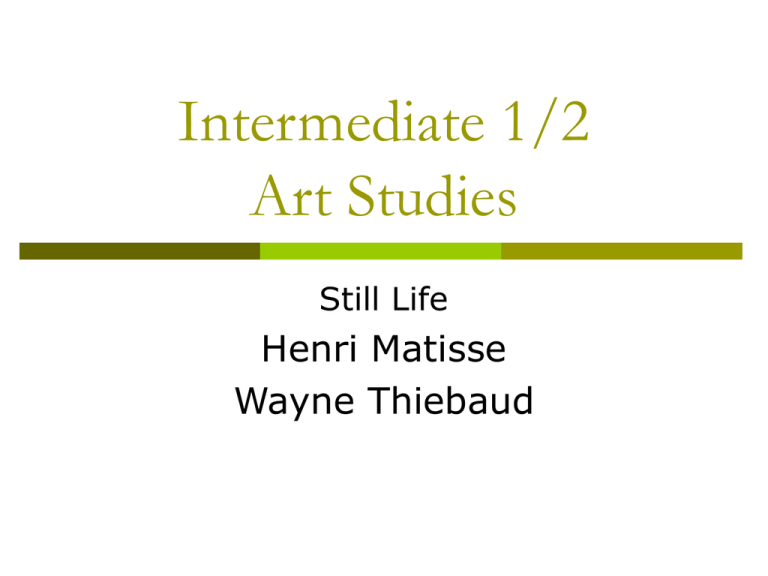
Intermediate 1/2 Art Studies Still Life Henri Matisse Wayne Thiebaud Henri Matisse (1869-1954) Henri Matisse (1869-1954) was a French painter and sculptor. Originally a law student, Matisse began to paint following an illness and went on to become one of the greatest artists of the modern period. To learn about composition, he copied old Masters in the Louvre, making his own variations. Matisse painted many different subject matters, from still life to figure and interior compositions. His later work was abstract (nonrepresentational) in nature and inspired by the natural environment. By 1905, his work began to show an abstract use of bold colour and he became a leader of Fauvism. Henri Matisse (1869-1954) ‘Les Fauves’, which translates as ‘wild beasts’ in French, were a group of artists who enjoyed painting pictures with outrageously bold colours. They received this title from a critic who was amused by this use of exaggerated colour, but many at the time did not like their work, feeling it too uncontrolled. ‘Les Fauves’ were the first group of artists to use colour to express their feelings about a subject, rather than just to describe it. Their paintings are known for being joyous and free. Henri Matisse (1869-1954) Part of Matisse’s success lay in realising the importance of simplicity in his drawing if using strong and exaggerated colour. By intensifying colours for expressive effect, he reduced the amount of detail in the shapes and forms of his chosen image. Matisse’s paintings commonly feature strong, vibrant colour, bold pattern and simple shapes. He worked loosely with his brushstrokes to create a sense of vitality and energy. Henri Matisse (1869-1954) In his later years, illness confined Matisse to a wheelchair and he struggled to paint. Instead he developed a collage technique, cutting shapes from colour paper. This work is actually among some of his best loved today. The reinvention of his style at an older age is proof of Matisse’s creative genius. ‘Bouquet Vase with Two Handles’ Oil on canvas (1907) ‘Still Life with Oranges’ Oil on canvas (1913) ‘Still Life with Oysters’ Oil on canvas (1940) ‘Interior with Eggplants’ Oil on canvas (1911) ‘Still Life with Magnolia’ Oil on canvas (1941) ‘Interior with an Egyptian Curtain’ Oil on canvas (1952) Wayne Thiebaud (1920-present) Wayne Thiebaud (pronounced Tee-bo) is an American painter whose most famous works include still life arrangements of cakes, pastries, sweets and cosmetics. As a teenager, Thiebaud was inspired by comic strips, establishing himself as a cartoonist and working for a time as an animator for Walt Disney Studios. He also spent time as a poster designer and commercial artist before deciding to become a painter, which can explain the pure visual style of his work. Wayne Thiebaud (1920-present) Thiebaud works in a very controlled way, using thick paint, exaggerated colour and carefully defined shadows to create very true to life pieces. Later in his career, he began to explore printmaking, which suited his clean, vivid style well. Wayne Thiebaud (1920-present) He is associated with the Pop Art movement because of his interest in objects of mass culture although most of his work was created prior to this movement, in the 1950’s and 1960’s. Where Pop Art reflected modern America and consumerism (think of Andy Warhol’s Campbell Soup, Coca-Cola and Marilyn Monroe images), Thiebaud’s subjects take a more nostalgic view. He is also associated with photorealism, due to the graphic representational style of his work. ‘Cakes’ Oil on canvas (1963) ‘Confections’ Oil on linen (1972) ‘Big Suckers’ Aquatint in colour (1970-71) ‘Eight Lipsticks’ Etching and aquatint (1988) ‘Celebration Cakes’ Pastel on paper (1996) ‘Cake Window (Seven Cakes)’ Oil on canvas (1970-76)
